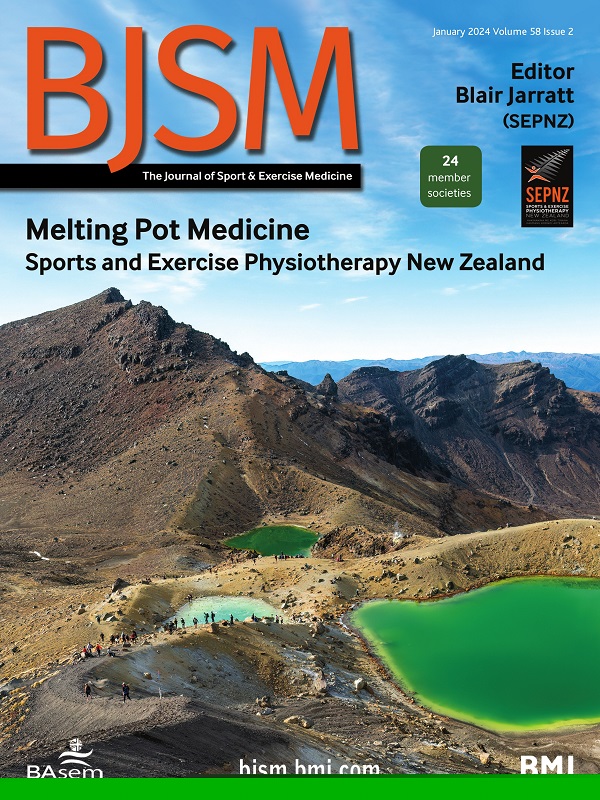运动相关损伤的性别和/或性别特异性考虑:女性、女性和/或女孩运动员损伤预防(FAIR)共识的概念映射方法。
IF 16.2
1区 医学
Q1 SPORT SCIENCES
引用次数: 0
摘要
目的本研究旨在收集和代表专家对与女/女/女童运动员受伤风险相关的性别和/或性别特异性因素的观点。方法混合方法概念映射研究。66位专家,包括(1)运动员/教练/护理人员,(2)临床医生,(3)运动科学/高性能专业人员,(4)管理人员和(5)研究人员,对一个提示(“你认为哪些性别和/或性别特定因素导致了女性、女性和女孩运动员的受伤风险?”)’),然后对陈述/因素的重要性和可修改性进行主题排序和评级(5点李克特量表)。结果由101个独特的语句/因子构建了10个聚类。分组(陈述数)包括:(1)不公平的组织资金和支持(n=17);(2)运动员缺乏和获得资源的情况(n=7);(3)支持人员缺乏知识和专业知识(n=6);(4)缺乏证据,以及性别和性别相适应的伤害预防的实施(n=20);(5)性别相关因素(n=14);(6)性别保健(n=8);(7)符合运动理想和规范的性别期望(n=10);(8)性别骚扰(人际暴力)和社会偏见(n=9);(9)体育环境性别化(7);(10)性别化沟通(n=3)。支持人员缺乏知识和专业知识被认为是解决与女/女/女童运动员受伤预防相关的性别和/或性别特定因素的最重要和可修改的集群。结论定义了可能影响女/女/女童运动员损伤危险因素的10个性别和/或性别特异性集群,范围从组织到生物学考虑和社会影响。迫切需要为性别和性别适当的伤害预防提供更有力的证据。本文章由计算机程序翻译,如有差异,请以英文原文为准。
Gender- and/or sex-specific considerations for sport-related injury: a concept mapping approach for the Female, woman and/or girl Athlete Injury pRevention (FAIR) consensus.
OBJECTIVE
This study aimed to gather and represent experts' perspectives on the gender- and/or sex-specific factors relevant to injury risk for female/woman/girl athletes.
METHODS
Mixed-methods concept mapping study. Sixty-six experts including cisgendered (1) athlete/coach/carers, (2) clinicians, (3) sports science/high-performance professional, (4) administrators and (5) researchers brainstormed statements to a prompt ('What gender-specific and/or sex-specific factors do you think contribute to injury risk among female, woman and girl athletes?') before thematically sorting and rating the statements/factors for importance and modifiability (5-point Likert scales).
RESULTS
Ten clusters were constructed from 101 unique statements/factors. The clusters (number of statements) include: (1) Inequitable organisational funding and support (n=17); (2) Athletes' lack of, and access to, resources (n=7); (3) Lack of knowledge and expertise among support staff (n=6); (4) Lack of evidence for, and implementation of gender and sex-appropriate injury prevention (n=20); (5) Sex-related factors (n=14); (6) Gendered health (n=8); (7) Gendered expectations to conform to athletic ideals and norms (n=10); (8) Gendered harassment (interpersonal violence) and social biases (n=9); (9) Gendered sport environment (7); (10) Gendered communication (n=3). Lack of knowledge and expertise among support staff was deemed the most important and modifiable cluster to address gender- and/or sex-specific factors relevant to injury prevention for female/woman/girl athletes.
CONCLUSION
Ten gender- and/or sex-specific clusters, ranging from organisational to biological considerations and societal influences, were defined that could impact female/woman/girl athlete injury risk factors. Advancing stronger evidence for gender and sex appropriate injury prevention is urgently needed.
求助全文
通过发布文献求助,成功后即可免费获取论文全文。
去求助
来源期刊
CiteScore
27.10
自引率
4.90%
发文量
217
审稿时长
3-8 weeks
期刊介绍:
The British Journal of Sports Medicine (BJSM) is a dynamic platform that presents groundbreaking research, thought-provoking reviews, and meaningful discussions on sport and exercise medicine. Our focus encompasses various clinically-relevant aspects such as physiotherapy, physical therapy, and rehabilitation. With an aim to foster innovation, education, and knowledge translation, we strive to bridge the gap between research and practical implementation in the field. Our multi-media approach, including web, print, video, and audio resources, along with our active presence on social media, connects a global community of healthcare professionals dedicated to treating active individuals.

 求助内容:
求助内容: 应助结果提醒方式:
应助结果提醒方式:


